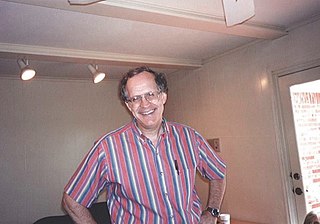
Elias Menachem Stein was an American mathematician who was a leading figure in the field of harmonic analysis. He was the Albert Baldwin Dod Professor of Mathematics, Emeritus, at Princeton University, where he was a faculty member from 1963 until his death in 2018.

Béla Bollobás FRS is a Hungarian-born British mathematician who has worked in various areas of mathematics, including functional analysis, combinatorics, graph theory, and percolation. He was strongly influenced by Paul Erdős since the age of 14.

In the field of mathematics known as functional analysis, the invariant subspace problem is a partially unresolved problem asking whether every bounded operator on a complex Banach space sends some non-trivial closed subspace to itself. Many variants of the problem have been solved, by restricting the class of bounded operators considered or by specifying a particular class of Banach spaces. The problem is still open for separable Hilbert spaces.

Jean Louis, baron Bourgain was a Belgian mathematician. He was awarded the Fields Medal in 1994 in recognition of his work on several core topics of mathematical analysis such as the geometry of Banach spaces, harmonic analysis, ergodic theory and nonlinear partial differential equations from mathematical physics.
Vaclav Zizler, Ph.D., Dr.Sc., is a Czech mathematics professor specializing in Banach space theory and non-linear spaces. As of 2006, Dr. Zizler holds the position of Professor Emeritus at the University of Alberta in Edmonton, Alberta, Canada. Formerly he was at the Mathematical Institute of the Czech Academy of Sciences where he was Head of Research. In 2001 the Czech Minister of Education named his Functional Analysis and Infinite Dimensional Geometry the university textbook of the year. In 2008 he was, for his excellent lifelong work in mathematical analysis and selfless activities in favour of the Czech mathematics, awarded a laureate medal by the Czech Mathematical Society.
In mathematics, nuclear spaces are topological vector spaces that can be viewed as a generalization of finite dimensional Euclidean spaces and share many of their desirable properties. Nuclear spaces are however quite different from Hilbert spaces, another generalization of finite dimensional Euclidean spaces. They were introduced by Alexander Grothendieck.
In mathematics, convex geometry is the branch of geometry studying convex sets, mainly in Euclidean space. Convex sets occur naturally in many areas: computational geometry, convex analysis, discrete geometry, functional analysis, geometry of numbers, integral geometry, linear programming, probability theory, game theory, etc.

Per H. Enflo is a Swedish mathematician working primarily in functional analysis, a field in which he solved problems that had been considered fundamental. Three of these problems had been open for more than forty years:

In mathematics, Hilbert spaces allow the methods of linear algebra and calculus to be generalized from (finite-dimensional) Euclidean vector spaces to spaces that may be infinite-dimensional. Hilbert spaces arise naturally and frequently in mathematics and physics, typically as function spaces. Formally, a Hilbert space is a vector space equipped with an inner product that induces a distance function for which the space is a complete metric space.
In functional analysis, a discipline within mathematics, an operator space is a normed vector space "given together with an isometric embedding into the space B(H) of all bounded operators on a Hilbert space H.". The appropriate morphisms between operator spaces are completely bounded maps.
In mathematics — specifically, in probability theory — the concentration dimension of a Banach space-valued random variable is a numerical measure of how "spread out" the random variable is compared to the norm on the space.

Sigurdur Helgason is an Icelandic mathematician whose research has been devoted to the geometry and analysis on symmetric spaces. In particular, he has used new integral geometric methods to establish fundamental existence theorems for differential equations on symmetric spaces as well as some new results on the representations of their isometry groups. He also introduced a Fourier transform on these spaces and proved the principal theorems for this transform, the inversion formula, the Plancherel theorem and the analog of the Paley–Wiener theorem.
In the mathematical field of functional analysis, a nuclear C*-algebra is a C*-algebra such that for every C*-algebra the injective and projective C*-cross norms coincides on the algebraic tensor product and the completion of with respect to this norm is a C*-algebra. This property was first studied by Takesaki (1964) under the name "Property T", which is not related to Kazhdan's property T.

Robert Ralph Phelps was an American mathematician who was known for his contributions to analysis, particularly to functional analysis and measure theory. He was a professor of mathematics at the University of Washington from 1962 until his death.
Hans Vilhem Rådström (1919–1970) was a Swedish mathematician who worked on complex analysis, continuous groups, convex sets, set-valued analysis, and game theory. From 1952, he was lektor at Stockholm University, and from 1969, he was Professor of Applied Mathematics at Linköping University.

Robert Stuart Doran is an American mathematician. He held the John William and Helen Stubbs Potter Professorship in mathematics at Texas Christian University (TCU) from 1995 until his retirement in 2016. Doran served as chair of the TCU mathematics department for 21 years. He has also held visiting appointments at the Massachusetts Institute of Technology, the University of Oxford, and the Institute for Advanced Study. He was elected to the board of trustees of the Association of Members of the Institute for Advanced Study, serving as president of the organization for 10 years. He has been an editor for the Encyclopedia of Mathematics and its Applications, Cambridge University Press, a position he has held since 1988. Doran is known for his research-level books, his award-winning teaching, and for his solution to a long-standing open problem due to Irving Kaplansky on a symmetric *-algebra.

Boris Isaac Korenblum was a Soviet-Israeli-American mathematician, specializing in mathematical analysis.
This is a glossary for the terminology in a mathematical field of functional analysis.










